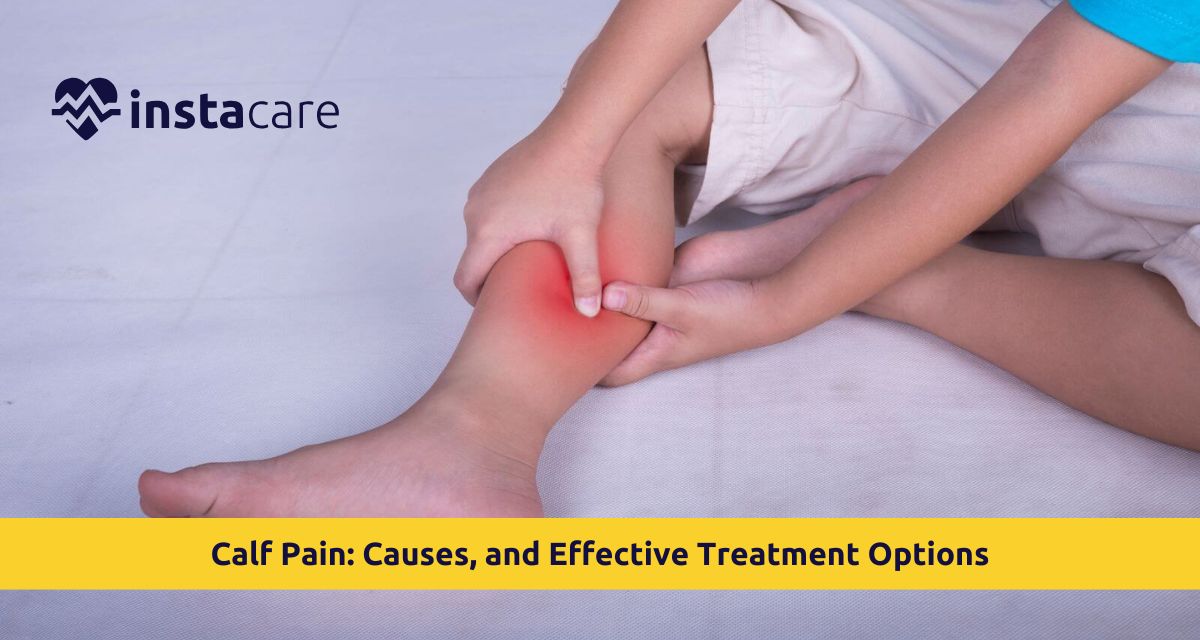Calf pain is a condition that affects all, regardless of age. Calf pain is of three categories i.e. mild, moderate, and severe, thus limiting movement as well as functioning properly. Calf pain necessitates consideration of the underlying cause to determine the most suitable treatment plan. Cause of calf pain and best treatment method are examined in the current blog.
What is Calf Pain?
Calf pain consists of painful sensations or ache-like feelings of the back portion of a lower leg. It lies between the knee and ankle joints. Calf pain may arise out of muscle strains, muscle cramps, or even from some underlying medical condition such as deep vein thrombosis. Depending on the cause of calf pain, the pain may feel either sharp, dull, or throbbing in nature.
Common Causes of Calf Pain
A variety of causes of calf pain, but they can't all be as likely to be the cause as others. It's really important to know the cause so the calf can be treated appropriately.
- Muscle Strains and Cramps: Muscle strain is tearing or stretching of calf muscle fibers. It occurs most often from excessive exercise like running or jumping or from eccentric muscle action like running downhill. Muscle cramps are spasm of calf muscles with acute, severe pain. They occur most often from dehydration, electrolyte imbalance, or repetitive overuse.
- Achilles Tendonitis: Tendon of calf muscle at back of heel, Achilles tendon, can become inflamed due to overuse, most often repetitive like jogging or sports athlete. Achilles tendonitis produces tightness and pain lower part of back leg.
- Deep Vein Thrombosis (DVT): DVT is clot of blood in a deep vein in the calf. It poses risk to the health of a person if the clot of blood dislodges and migrates to the lung and results in pulmonary embolism. The DVT-related pain, swelling, and limb redness should receive immediate medical treatment.
Calf Pain and Peripheral Artery Disease (PAD)
PAD is a condition of circulatory disorder in which peripheral arteries of the legs get obstructed or jammed and hence are unable to provide a usual amount of blood. It causes pain or discomfort in the leg and is aggravated on walking or exercise. It is likely to occur in diabetic patients,
hypertension, or in smokers.
Sciatica technically means the lower back but to pain that travels all the way to the calf, and all the way to the leg. Sciatica results from compression or irritation of the sciatic nerve, which runs from the lower back to the legs.
Trauma or Fracture Pain Leg trauma or a fracture caused by a fall or accident can also cause calf pain. Although not as frequent, fractures or trauma need to be checked and diagnosed by a doctor as soon as possible so they can heal properly.
Successful Calf Pain Treatments
The kind of cause of pain in the calf will also dictate the kind of treatment for it. There are a number of things that will heal and nullify pain regardless.
- Rest and Ice: Rest is the most crucial aspect of calf strain rehabilitation. Avoid straining activity on the calf, such as running or standing for hours. Apply ice to the inflamed area to reduce swelling and numbing pain. Ice treatment must be 15–20 minutes at each several-hour interval within the first 48 hours of the injury.
- Compression and Elevation: A Compression bandage of the calf prevents swelling. Rest and elevation of the leg to the level of the heart above prevent fluid entry into the area and thus swelling.
- Over-the-Counter Pain Relievers: Nonsteroidal anti-inflammatory drugs (NSAIDs) like ibuprofen or aspirin inhibit pain and swelling. Always read instructions and labels and administer the drug in recommended dosages without side effects.
- Strengthening and Stretching Exercises: As soon as the pain has passed, the calf muscle can be stretched slowly out. Strengthening exercises can also be used to keep the recurrence at bay by building muscles that will shield the calf. A physical therapist will create an individualized regimen of strengthening and stretching.
- Hydration and Electrolytes: Hydration and the restoration of the potassium, calcium, and magnesium, mineral levels must be treated for cramps caused by dehydration or electrolyte loss. Consuming large amounts of water and mineral-rich foods such as bananas, spinach, and milk products will treat cramps.
- Massage and Physical: Therapy Massage is also employed to relax tension and tightness in calf muscles. Deep tissue massage is employed independently for healing and improving circulation. Calf pain, if occurs frequently, can be treated a physical therapy. A physical therapist can prescribe some therapy and exercises such that the pain would not recur.
- Compression Stockings: Compression stocking can improve blood circulation, reduce swelling, and alleviate pain in circulatory disease patients such as PAD. Compression stockings are worn to encircle the legs and exert gentle pressure so that the blood circulation improves.
- Surgery: Worst possible condition, i.e., rupture of Achilles tendon or fracture, is treated with the most optimal treatment course as surgery. Surgery is recommended most classically when nonsurgical treatment is a failure to ease pain or high risk of complication onset.
Prevention of Calf Pain
While calf pain cannot always be avoided, there are some measures which can be followed to ensure that one acquires it less often in the future.
- Warm Up Before Exercise: Always warm up prior to exercising any type of physical exercise. This preps the muscles for exercising, and it is less probable to strain or get hurt. Including dynamic stretching in your warm-up will stretch calf muscles.
- Wear Supportive: Shoes Supportive shoes and proper posture are dependent to a great extent on proper, supportive shoes. You should have cushioned and supported shoes under the arch level if you are doing high-impact exercise.
- Be Properly Hydrated and Balancing with Electrolytes: Dehydration is the main cause for cramps. Drinking many glasses of water during the day, especially when a person exercises or is physically active, is extremely important. Foodstuffs that are high in potassium, calcium, and magnesium stop cramps.
- Include Strengthening and Flexibility Exercises: Day calf muscle stretching loosens its tightness so that it does not get injured. It must also make it hard and elastic enough to become strained whenever calf muscle is stretched through calf raises.
- Gradual Increase in Activity: If you’re starting a new exercise regimen, gradually increase the intensity and duration of your activities. Overloading your calf muscles too quickly can lead to strains or injuries. Take it slow to allow your body to adjust.
Conclusion
Calf pain mostly stems from muscle strain yet its appearance may warn about potentially serious medical issues including DVT or PAD. The treatment of muscle strain injuries requires the combination of rest along with ice application while using compression materials and performing gentle stretches to reduce discomfort. The specific diagnosis depends on evaluating how pain feels along with its length of occurrence. Getting medical advice in uncertain situations will enable you to receive appropriate and timely medical attention.
Please book an appointment with the
best General Physician in Lahore, Karachi, Islamabad, and all major cities of Pakistan through
InstaCare, or call our helpline at 03171777509 to find a verified doctor for your disease.

